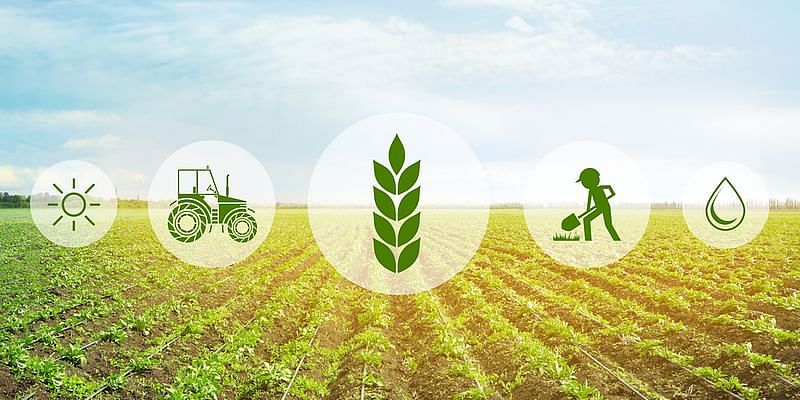Traditional agriculture has a whole variety of issues and risks in agriculture methods, yet it feeds most of our 1.3 billion people. The 2 key factors to success in traditional agriculture are profitability and sustainability. When achieved, these lead to longevity and reinvestment with the help of agriculture risk assessments.
Another factor is size. The average farm size in India is a little over 1 hectare (Livemint) and an average farm in the United States is over 174 hectares (USDA). This creates inefficiency, lack of bargaining power and profitability, eventually hampering reinvestment and progress.
Of course, there are also several other risks and uncertainty in farm management like weather risk, which has been exaggerated by climate change. Unpredictable weather has affected natural growing patterns for several crops and remains one of the hardest risks in farming to be mitigated on a nationwide scale.
Apart from this, several systemic issues do more harm than good. The government-subsidised water for small farmers, which leads to incorrect growing patterns. Several drought-prone regions grow sugarcane, which consumes a lot of water. But since water is subsidised, farmers seek short term profitability over falling groundwater levels and soil health. With the help of agricultural risk management strategies, one can find a way out of risks in agriculture for better use of government subsidies.
In the past decade, vertical farming and Agritech have seemed like the saving grace for this industry. Yet, given our growing population base, it is imperative that we focus on improving the state of traditional agriculture, rather than gravitate towards the latest hype. This article will examine the risks associated with these methods and propose a more sustainable, scalable and profitable method for agriculture.
For clarity, when I refer to urban agriculture, I am specifically referring to small to medium scale, highly intensive and precision controlled farming. Examples of this include hydroponics, aeroponics, other versions of vertical farming, polyhouse farming, etc. These methods have their benefits: they save a lot of space and water, reduce transport costs drastically, create better quality produce and so on.
The biggest risk in vertical farming is the business feasibility. Vertical farming setups are expensive: costing up to INR 4,000,000 ($55000) per acre. The high capital investment makes scalability the challenge.
Added to this, the variety of produce grown is extremely limited. Any fruit that requires a standing tree cannot be grown. Most vertical farms grow the same produce that you could grow in houseplants – greens, tomatoes, root vegetables, etc.
Finally, vertical farming requires precision. Precision means controlled temperature, humidity, water and nutrition. This may seem like it’s mitigating a lot of climate risk that we see in traditional agriculture. In my experience, fighting external conditions is difficult. Several vertical farms have moved out of Mumbai because it is too hard to maintain internal farm humidity when you are fighting natural conditions. Leaks arise and destroy the system and without proximity to cities, they add little value to the overall food ecosystem.
India’s small average farm size hurts Agritech adoption. Farmers don’t produce enough profit to invest in future growth and Agritech is considered a luxury offering. Agritech has not yet reached the critical mass that it desperately needs for take-off. Most Agritech products aren’t suitable for smaller sized farmers and just don’t add enough value to justify another upfront investment.
Still, I remain optimistic about Agritech. Larger farms do benefit from technology adoption. Also, the sector is relatively new and most private investment has only come over the past decade. Down the line, Agritech may be the solution to India’s farming issues.
Agro-forestry is the commercial growth of forest produce like timber, rubber, bamboo, etc. National forests have historically been one of the most protected assets by the Government of India, with good reason. Risks with agroforestry are largely systemic. Any private land used for agroforestry is, in theory, regulated the same as national forests.
This makes operations remarkably slow and frustrating. You purchase land with your capital, invest into planting new trees and maintaining them for upwards of 15 years and then, you must seek the Government’s permission to harvest your produce. This process is riddled with bureaucracy, corruption and documentation. At this point, there is no motivation for anyone to get into agroforestry of any kind in India.
We are already witnessing the early stages of consolidation in Indian agriculture. Due to its tax free nature and farmer desperation for liquidity, wealthier individuals and investors are looking for alternative investments which are buying large tracts of farmland. This may solve some of the issues addressed above, like technology adoption.
Yet, how do we make agriculture, at any scale, profitable and sustainable?
Over the past few years, there has been growing chatter about multilayer farming. Traditionally, flat pieces of farmland grew one or two crops at a time. Multilayer farming suggests using the full available height above the ground, as well as the space below the surface.
The key to success here is crop selection: – Generally, one root vegetable is chosen that grows below the surface of the ground (Level 1), – Next, a leafy green crop like spinach is chosen that grows just on the surface (Level 2), – Next, a low height crop (2-3 feet tall) like ladyfinger is chosen (Level 3),
– Followed by a small tree (6-10 feet tall) like a banana (Level 4),
– A larger tree (12-20 feet tall) like papaya (Level 5),
– Finally, a creeper like black pepper can climb on the larger tree (Level 6).
This works because different heights do not compete for sunlight and different root depths do not compete for nutrients. When done right, multilayer farming can generate up to 5x the financial return compared to normal farming, while using 90% less water. The variety of crops also lowers the risk of pests and crop failure, while generating income year-round, given different harvest seasons.
The main risk with this method is education. Farmers need to learn the method from the ground up to reap its full reward. Also, older farmers are generally sceptical of the proposed results, so it is tougher to get adoption from them.
Parting Thoughts
Agritech funding tripled from 2018 to 2019 and doubled from 2019 to 2020. Approximately $500 was invested into Agritech start-ups in 2020, a clear step in the right direction. The sector will attract our best minds, given the size of the opportunity – a $100 billion dollar market. Innovation in India’s agriculture sector is happening every day and breakthroughs are around the corner.
Article Published by: Mr. Rohan Lodha – Chief Farmer at KSL Agro












